Hedy Lamarr, the Beautiful Girl Who Discovered Bluetooth Systems to WiFi

Image source: Fox5sandiego.com
The Internet is now a reliable network by smartphone users. Without the network, the device could have lost its nickname as a smart phone.
The network is increasingly loved by users once their capabilities are accessed wirelessly. But who invented the wireless system?
Quoted from various sources, is Hedy Lamarr who has an important role in the presence of wireless systems that are now the basis of WiFi systems, Bluetooth, and GPS. Various wireless system products that are now still very simanfaatkan by many users of technology devices.
Hedy Lamarr was born to Emil Kiesler and Getrud on November 9, 1914 in Vienna, Austria. Hedy Lamarr himself is a popular name, while his birth name is Hedwig Eva Maria Kiesler.
Hedy Lamarr is of Jewish origin because his parents are Jewish.
At the age of 17, Hedy Lamarr appeared in a German film titled Geld Auf Der Strase. His entertainment career continues to crawl to bring him to Hollywood.
Upon entering Hollywood he changed his name to Hedy Lamarr. His first film in Hollywood aired in 1938. He was a success in the entertainment world even known as the most beautiful woman in the movie at that time.
During his career in the entertainment world, he is known for his scenes in a sensual film.
At that time he married the richest man in Austria, Friedrich Mandl. But he felt her husband confined himself to acting so he fled to Paris and developed his career.
George Anthiel, an avant-garde composer who happens to be Hedy Lamarr's neighbor while living in California is a German immigrant son. He experimented with automatic control of musical instruments especially for the music he created for Ballet Mecanique.
At the time of the Second World War when Lamarr and Antheil discussed how radio-controlled torpedoes used in naval warfare can be intercepted by broadcasting certain disturbances on signal-frequency controls that would eventually get a torpedo accidentally.
Together with Anthiel, Lamarr developed a "Secret Communications System" designed to help fight the Nazis. They achieve this achievement by manipulating radio frequencies at irregular intervals during reception or transmission.
Their invention forms a sort of unbreakable code that prevents the dissemination of information and secret messages from interception by people who are not their allies.
Lamarr gained his knowledge of torpedoes from his first husband, Mandl and he used his knowledge to help develop this discovery. With Anthiel combining the use of piano rolls, they managed to unleash the frequency jump. They use 88 piano buttons to convert randomly signal in the range of 88 frequencies.
In 1942 when a patent for the discovery of Antheil and Hedy Lamarr was given. However, early versions of the frequency jump technique they designed were met with resistance by the US navy and hence their findings were not adopted. Their notion was not used by the navy until 1962, the military used it for the Cuban blockade after the patent expired.
In 1997, the discovery was honored because the Electronic Frontier Foundation honored Lamarr for his contribution to this technology. The findings are the basis of Bluetooth technology, Wi-Fi connection, and CDMA.
During his life, Hedy Lamarr married six times and was blessed with three children. In 1953 Lamarr became a citizen of the United States (US). An autobiography herself seemed to corner Hedy Lamarr, who was later dismissed by him.
In her age older exactly in the 1970s, a period where he alienated himself. Hedy Lamarr was offered the script, television commercials and even projects for the stage. But none of the offers were taken by Lamarr.
In 1981, he had trouble with his eyesight and chose to go into Miami Beach in Florida. January 2000, Lamarr died in Florida because of heart problems. Although his work in the entertainment world reap the controversy, his contribution in the world of science ushered in wireless technology is useful to date.
Reference source:
1. Okezone.com
2. Fox5sandiego.com
3. Forbes.com
4. Wikipedia.org
